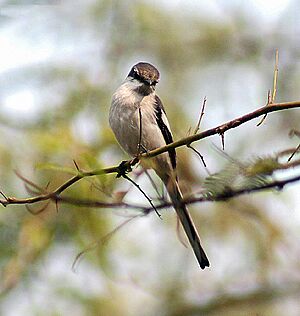White-bellied minivet facts for kids
Quick facts for kids White-bellied minivet |
|
|---|---|
 |
|
| at Bharatpur, Rajasthan, India. | |
| Conservation status | |
| Scientific classification | |
| Synonyms | |
|
The white-bellied minivet (Pericrocotus erythropygius) is a colorful bird found in India. It mostly lives in dry forests where trees lose their leaves every year.
Contents
About the White-Bellied Minivet
The name "minivet" is thought to come from an old Indian word. The scientific name for minivets, Pericrocotus, might be linked to the bright orange or saffron color seen on some of these birds.
What Does It Look Like?
The male white-bellied minivet is quite striking. It has a shiny black head, neck, and tail. Its back is also black. You can spot a white band around its neck. The male's throat is orange, and the rest of its belly is white. It also has orange on its lower back (rump) and white marks on its wings.
Female minivets look a bit different. They are not as bright as the males. Females have dark gray upper parts and black wings. They also have a white collar and a black tail. Like the males, their wings have white markings, and their rump is orange.
These birds are usually about 18.5 to 20 centimeters (about 7 to 8 inches) long.
Where Do They Live and What Do They Do?
The white-bellied minivet lives in Nepal and India. They prefer dry deciduous forests, which are forests where trees lose their leaves each year. You can also find them in open grasslands with a few acacia trees. They sometimes live in farm areas too. These birds cover a very large area, more than 20,000 square kilometers (about 7,700 square miles)!
Minivets usually travel in small groups. Sometimes, they even join groups of other bird species. They mostly eat insects. They are good at catching insects while flying or by sitting on tree branches and spotting their prey.
Their call is a pleasant, whistling sound.
Life Cycle and Reproduction
White-bellied minivets build their nests high up in tree tops. Their nest is shaped like a cup. They carefully weave it together using small twigs and spider webs. The spider webs help make the nest strong.
A female minivet usually lays four eggs. The eggs hatch after about 17 to 18 days. The female bird does most of the incubation, which means keeping the eggs warm. However, both parents help take care of the young birds once they hatch.
Types of White-Bellied Minivets
There are two main types, or subspecies, of the white-bellied minivet:
- P. e. albifrons: This type is found in the central plains of Myanmar.
- P. e. erythropygius: This type lives in India, from areas like Punjab and Rajasthan all the way to Bihar and Mysore.
How Are They Doing?
The number of white-bellied minivets is steady. Because of this, the IUCN considers them a "least concern" species. This means they are not currently at risk of disappearing.
Images for kids




